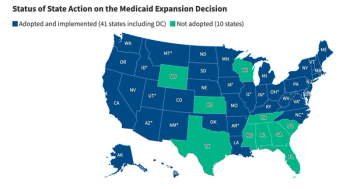
Benefits Leaders Seek Data-driven Solutions
Organizations that are ahead of the curve are more likely to rely on data analytics to develop innovative benefits programs.
Just 18% of benefits leaders at companies nationwide believe their benefits programs are ahead of the curve-and 19% fear their organizations are falling behind industry standards in benefits design, an
Artemis Health surveyed 300 human resources and benefits leaders from U.S. companies with 5,000 or more employees to determine the needs of benefits leaders at a time when group plans are becoming more complex and employee expectations are rising.
“In an era of increased complexity, competition, and changing expectations, the ability to harness data quickly-from multiple sources-is a competitive differentiator,” says Grant Gordon, CEO of Artemis Health. “The survey shows organizations that are ahead of the curve on benefit design are significantly more likely to rely on data analytics and business intelligence solutions to develop innovative benefit programs that create value.”
But access to the right data at the right time remains a challenge, according to 53% of benefits leaders. Other challenges include the length of time it takes to run reports, difficulties connecting disjointed data sources, and lack of trust in data accuracy.
With the price of family coverage topping
Related:
“For health plan leaders, this means employers are taking an even more critical look at what they are getting from five-figure health plan premiums,” he says. “They expect fast, accurate access to healthcare data. They expect health plans to more actively partner with them in designing programs that improve the health of vulnerable populations. Additionally, employers are increasingly looking for opportunities for direct contracting with health systems, and data will play a key role in ironing out these partnerships.”
For provider executives, it means employers are using quality and cost data to incentivize the use of providers with proven track records for improving employee health outcomes, according to Gordon.
“Providers that wish to keep employers’ business will need to collaborate with employers to develop data-driven solutions for health improvement,” he says. “For example, at GE Appliances, benefits leaders are using quality data to determine which providers to partner with in creating bundled payment programs, such as for maternity care and substance use disorder.”
According to Gordon, these programs are critical not only in moving away from fee-for-service payment, but also in improving health outcomes for employees and their families and, ultimately, reducing healthcare costs for the organization.
“An analysis of employee health data by GE Appliances also has pointed to the value of onsite primary care clinics, which perform better in lowering hypertension and adhering to evidence-based guidelines for diabetes when compared to community care providers,” Gordon says.
When making decisions about their benefits programs, benefits leaders report their top three goals are to increase employee productivity (47%), improve employee satisfaction (43%), and improve employee health and well-being (36%). However, companies rank these goals differently according to their size. For example, companies with 5,000 to 9,999 employees rank “increasing employee productivity” as their top goal for benefits programs, while companies with 10,000 to 24,999 employees say their top benefits program goal is “improving employee satisfaction.” For companies with 25,000 employees or more, “improving employee health and well-being” is the top goal.
“Employers are also more focused than ever on gathering employee feedback on their benefits programs,” Gordon says. “They reported employee feedback as their top resource when conducting benefits plan design.”
Additionally, employers trust their benefits consultants and brokers, but do not rely on them exclusively for strategic decision-making.
“There is an opportunity for benefits advisors to take on a bigger role in benefits strategy and design,” he says.
Data intelligence makes the difference, according to Gordon. “Organizations that are ahead of the curve are significantly more likely to rely on data analytics and business intelligence solutions to develop innovative benefit programs that create value,” he says.
“Benefits leaders are often stopped in the hallway by a CFO and asked about healthcare costs, in-network versus out-of-network providers, or enrollment numbers,” Gordon adds. “Benefits analytics is the key to feeling confident in these conversations and building better benefits programs for their organizations and their employees.”
Newsletter
Get the latest industry news, event updates, and more from Managed healthcare Executive.





















































